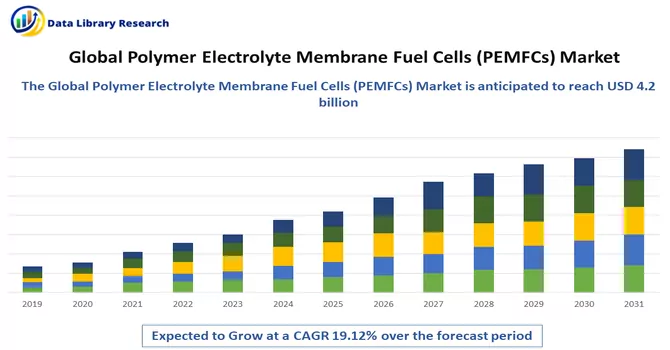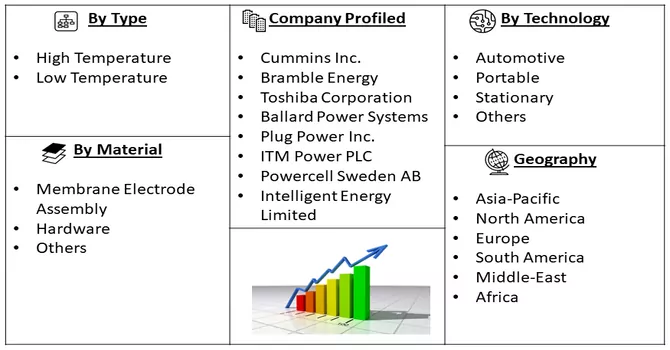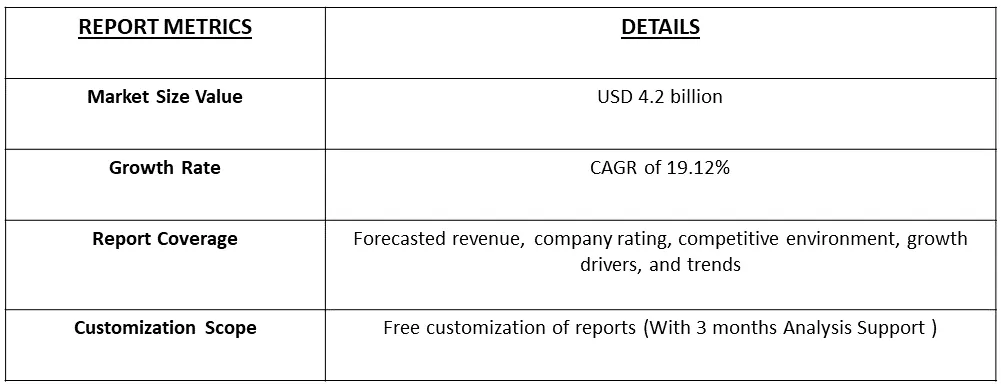The Polymer Electrolyte Membrane Fuel Cells Market size is estimated at USD 4.2 billion in 2023 and is expected to reach a CAGR of 19.12% during the forecast period (2024-2031).

Get Complete Analysis Of The Report - Download Free Sample PDF
Polymer Electrolyte Membrane Fuel Cells (PEMFCs) hold a pivotal position in the burgeoning fuel cell market, offering a clean and efficient energy conversion solution. These fuel cells operate on the principle of electrochemical reactions between hydrogen and oxygen, facilitated by a polymer electrolyte membrane. PEMFCs are characterized by their quick start-up, high power density, and suitability for various applications, ranging from transportation to stationary power generation. The automotive sector, in particular, has witnessed increasing adoption of PEMFCs for fuel cell electric vehicles (FCEVs) due to their fast response times and potential for zero-emission transportation.
The market for PEMFCs is further driven by ongoing advancements in materials, design, and manufacturing processes, aiming to enhance efficiency, reduce costs, and broaden the commercial viability of this eco-friendly energy technology. As the global focus on clean energy intensifies, PEMFCs play a crucial role in the transition towards sustainable and low-carbon energy solutions. The growth of the Polymer Electrolyte Membrane Fuel Cell (PEMFC) market is significantly driven by the increasing global emphasis on sustainable and clean energy solutions. PEMFCs offer a highly efficient and environmentally friendly alternative for energy conversion, particularly in applications such as transportation and stationary power generation. The accelerating demand for zero-emission vehicles, coupled with governmental initiatives promoting clean energy, propels the adoption of PEMFCs in the automotive sector, particularly in fuel cell electric vehicles (FCEVs). Ongoing research and development efforts aimed at enhancing the performance and cost-effectiveness of PEMFCs contribute to their growing commercial viability. Additionally, the versatility of PEMFCs, their quick start-up times, and high power density further fuel their integration into various applications, contributing to the overall expansion of the PEMFC market. As the world strives for sustainable energy solutions and a reduction in carbon emissions, PEMFCs stand out as a key driver in the transition towards a cleaner and more eco-friendly energy landscape.
Market segmentation: Global PEMFC Market & PEM Fuel Cell Manufacturers and the market is segmented by Application (automotive, stationary power generation, portable power, and others.) and Geography (North America, Europe, Asia-Pacific, Rest of the World). The report offers the market size and forecasts in terms of revenue in USD billion for all the above segments.

For Detailed Market Segmentation - Download Free Sample PDF
Market trends in the Polymer Electrolyte Membrane Fuel Cell (PEMFC) sector reveal a dynamic landscape shaped by advancements in technology and a growing focus on sustainable energy solutions. One notable trend is the increasing interest in hydrogen as a clean fuel, driven by its potential for storing and delivering renewable energy. PEMFCs, known for their efficiency in converting hydrogen to electricity, are witnessing heightened attention in applications ranging from vehicles to backup power systems. The integration of PEMFCs in the transportation sector is gaining momentum, with a surge in fuel cell electric vehicle (FCEV) development by major automotive manufacturers. Furthermore, research and development efforts focus on improving the durability, cost-effectiveness, and overall performance of PEMFCs, aiming to broaden their commercial applicability. As hydrogen infrastructure continues to develop globally, and industries seek sustainable energy solutions, PEMFCs are poised to play a pivotal role in shaping the future of clean energy technologies.
Market Drivers:
The global push towards decarbonization has elevated hydrogen as a crucial element in the transition to cleaner energy
The global push towards decarbonization has elevated hydrogen to a central position in the transition to cleaner energy, underscoring its pivotal role in sustainable and low-carbon solutions. As nations strive to mitigate the impacts of climate change, hydrogen has emerged as a versatile energy carrier capable of decoupling economic growth from carbon emissions. The versatility of hydrogen allows its integration into various sectors, including industry, transportation, and energy production, fostering a comprehensive shift towards greener practices. In particular, the focus on green hydrogen, produced through renewable energy sources, aligns with the goals of achieving a carbon-neutral future. This emphasis on hydrogen as a key element in decarbonization efforts reflects a collective global commitment to fostering a cleaner, more sustainable energy landscape.
The rising interest and investments in sustainable transportation solutions drive the adoption of PEMFCs in FCEVs
The rising interest and investments in sustainable transportation solutions are steering the adoption of Polymer Electrolyte Membrane Fuel Cells (PEMFCs) in Fuel Cell Electric Vehicles (FCEVs). With an increasing global focus on reducing carbon emissions and promoting environmentally friendly mobility options, PEMFCs have gained prominence due to their efficiency in converting hydrogen into electricity, offering a clean alternative to traditional internal combustion engines. Major automotive manufacturers are directing substantial resources towards the development and commercialization of FCEVs, recognizing the potential of PEMFCs to deliver longer driving ranges and shorter refuelling times compared to other electric vehicles. Government incentives and regulations promoting zero-emission transportation further catalyze the integration of PEMFCs in the automotive sector. This trend reflects a collective commitment to advancing sustainable transportation solutions and underscores PEMFCs as a key enabler in the transition towards greener and more energy-efficient mobility.
Market Restraints:
The Polymer Electrolyte Membrane Fuel Cell (PEMFC) market faces several constraints that impact its widespread adoption. One significant restraint is the high cost associated with the production of PEMFCs, primarily due to the use of expensive materials such as platinum as catalysts. This cost factor poses a challenge in making PEMFCs economically competitive compared to other energy conversion technologies. Another limitation is the infrastructure required for hydrogen refuelling stations, which remains underdeveloped in many regions, hindering the broader implementation of fuel cell vehicles. Additionally, the durability and lifespan of PEMFCs, particularly in high-stress environments such as automotive applications, present technical challenges that need to be addressed for widespread market acceptance. The overall lack of a standardized regulatory framework and consistent policies supporting fuel cell technologies can also impede investment and hinder market growth. As the industry strives to overcome these challenges, advancements in materials, infrastructure development, and regulatory support will be crucial for unlocking the full potential of the PEMFC market.
The COVID-19 pandemic has presented both challenges and opportunities for the Polymer Electrolyte Membrane Fuel Cell (PEMFC) market. On one hand, the disruptions in global supply chains and manufacturing processes during lockdowns led to delays in production and deployment of PEMFC technologies. Project timelines were affected, and investment decisions faced uncertainties due to economic slowdowns. On the other hand, the pandemic has accelerated certain trends that favour the adoption of PEMFCs. The heightened awareness of environmental sustainability and the need for resilient energy solutions gained prominence during the crisis. Governments and industries have shown an increased commitment to green recovery initiatives, potentially fostering greater support for PEMFC technology. As the world emerges from the pandemic, the PEMFC market may witness renewed interest and investments, particularly if there is a sustained focus on building back economies with a commitment to clean energy and low-carbon technologies.
Segmental Analysis:
Automotive Segment is Expected to Witness Significant Growth Over the Forecast Period
The Polymer Electrolyte Membrane Fuel Cell (PEMFC) market is rapidly expanding in the automotive segment, driven by the need for cleaner and more sustainable energy solutions. PEMFCs offer several advantages for automotive applications, including higher energy efficiency, lower emissions, and faster refuelling times compared to traditional internal combustion engines. These features make PEMFCs an attractive alternative for automakers looking to reduce their carbon footprint and comply with stricter emission regulations. One of the key drivers for the adoption of PEMFCs in the automotive sector is their ability to provide long driving ranges and quick refuelling times, addressing two critical concerns for consumers considering electric vehicles (EVs). Additionally, PEMFCs can be used in conjunction with batteries in hybrid vehicles, offering a flexible and efficient powertrain solution. Several automakers are already investing heavily in PEMFC technology, with some models already on the market. As the infrastructure for hydrogen refuelling stations continues to expand, the adoption of PEMFCs in the automotive sector is expected to grow significantly in the coming years. Overall, PEMFCs are poised to play a significant role in the transition to a cleaner and more sustainable transportation system.
North America Region is Expected to Witness Significant Growth Over the Forecast Period
North America is a key region driving the growth of the Polymer Electrolyte Membrane Fuel Cell (PEMFC) market, with a strong emphasis on clean energy solutions and stringent environmental regulations. The region's focus on reducing carbon emissions and promoting sustainable transportation has led to increased investment in PEMFC technology, particularly in the automotive sector. Major automotive manufacturers in North America are exploring PEMFCs as a viable alternative to traditional internal combustion engines, given their higher energy efficiency and lower emissions. Additionally, the region has a well-established infrastructure for hydrogen refuelling stations, which is crucial for the widespread adoption of PEMFC-powered vehicles. As a result, North America is expected to continue to be a key market for PEMFCs, driving innovation and growth in the industry.

Get Complete Analysis Of The Report - Download Free Sample PDF
The analyzed market exhibits a high degree of fragmentation, primarily attributable to the presence of numerous players operating on both a global and regional scale. The competitive landscape is characterized by a diverse array of companies, each contributing to the overall market dynamics. This fragmentation arises from the existence of specialized solution providers, established industry players, and emerging entrants, all vying for market share. The diversity in market participants is underscored by the adoption of various strategies aimed at expanding the company's presence. On a global scale, companies within the studied market are strategically positioning themselves through aggressive expansion initiatives. This often involves entering new geographical regions, targeting untapped markets, and establishing a robust global footprint. The pursuit of global expansion is driven by the recognition of diverse market opportunities and the desire to capitalize on emerging trends and demands across different regions. Simultaneously, at the regional level, companies are tailoring their approaches to align with local market dynamics. Regional players are leveraging their understanding of specific market nuances, regulatory environments, and consumer preferences to gain a competitive edge. This regional focus allows companies to cater to the unique needs of local clientele, fostering stronger market penetration. To navigate the complexities of the fragmented market, companies are implementing a range of strategies. These strategies include investments in research and development to stay at the forefront of technological advancements, mergers and acquisitions to consolidate market share, strategic partnerships for synergies, and innovation to differentiate products and services. The adoption of such multifaceted strategies reflects the competitive nature of the market, with participants continually seeking avenues for growth and sustainability. In essence, the high fragmentation in the studied market not only signifies the diversity of players but also underscores the dynamism and competitiveness that drive ongoing strategic manoeuvres. As companies explore various avenues for expansion, the market continues to evolve, presenting both challenges and opportunities for industry stakeholders. Some of the key market players working in this market are:
Recent Development:
1) In April 2022, German companies SFC Energy and FC TecNrgy formalized an agreement aimed at manufacturing fuel cells utilizing methanol and hydrogen within India. This strategic partnership is anticipated to contribute significantly to India's ambitious hydrogen targets, aligning with plans to produce up to 5 million tonnes of green hydrogen by the year 2030. Alongside this collaboration, SFC Energy also unveiled the EFOY hydrogen fuel cell in the Indian market, a development poised to play a pivotal role in the nation's hydrogen infrastructure. The introduction of such innovative fuel cell technologies reinforces the commitment to cleaner energy solutions and positions India as a key player in the global hydrogen landscape.
2) In October 2021, Panasonic Corporation unveiled a milestone achievement with the development of a pure hydrogen fuel cell generator. This innovative generator harnesses power through a chemical reaction involving high-purity hydrogen and oxygen from the air. Panasonic's breakthrough in hydrogen fuel cell technology reflects a broader industry trend toward cleaner and more sustainable power generation methods. The development holds the potential to contribute to a greener energy future by providing a reliable and efficient source of electricity while minimizing environmental impact.
Q1. What was the Polymer Electrolyte Membrane Fuel Cells Market size in 2023?
As per Data Library Research the Polymer Electrolyte Membrane Fuel Cells Market size is estimated at USD 4.2 billion in 2023.
Q2. At what CAGR is the market projected to grow within the forecast period?
Polymer Electrolyte Membrane Fuel Cells Market is expected to reach a CAGR of 19.12% over the forecast period.
Q3. Which Region is expected to hold the highest Market share?
North America region is expected to hold the highest Market share.
Q4. Who are the key players in Polymer Electrolyte Membrane Fuel Cells Market?
Some key players operating in the market include
Data Library Research are conducted by industry experts who offer insight on industry structure, market segmentations technology assessment and competitive landscape (CL), and penetration, as well as on emerging trends. Their analysis is based on primary interviews (~ 80%) and secondary research (~ 20%) as well as years of professional expertise in their respective industries. Adding to this, by analysing historical trends and current market positions, our analysts predict where the market will be headed for the next five years. Furthermore, the varying trends of segment & categories geographically presented are also studied and the estimated based on the primary & secondary research.
In this particular report from the supply side Data Library Research has conducted primary surveys (interviews) with the key level executives (VP, CEO’s, Marketing Director, Business Development Manager and SOFT) of the companies that active & prominent as well as the midsized organization
FIGURE 1: DLR RESEARH PROCESS

Extensive primary research was conducted to gain a deeper insight of the market and industry performance. The analysis is based on both primary and secondary research as well as years of professional expertise in the respective industries.
In addition to analysing current and historical trends, our analysts predict where the market is headed over the next five years.
It varies by segment for these categories geographically presented in the list of market tables. Speaking about this particular report we have conducted primary surveys (interviews) with the key level executives (VP, CEO’s, Marketing Director, Business Development Manager and many more) of the major players active in the market.
Secondary ResearchSecondary research was mainly used to collect and identify information useful for the extensive, technical, market-oriented, and Friend’s study of the Global Extra Neutral Alcohol. It was also used to obtain key information about major players, market classification and segmentation according to the industry trends, geographical markets, and developments related to the market and technology perspectives. For this study, analysts have gathered information from various credible sources, such as annual reports, sec filings, journals, white papers, SOFT presentations, and company web sites.
Market Size EstimationBoth, top-down and bottom-up approaches were used to estimate and validate the size of the Global market and to estimate the size of various other dependent submarkets in the overall Extra Neutral Alcohol. The key players in the market were identified through secondary research and their market contributions in the respective geographies were determined through primary and secondary research.
Forecast Model
